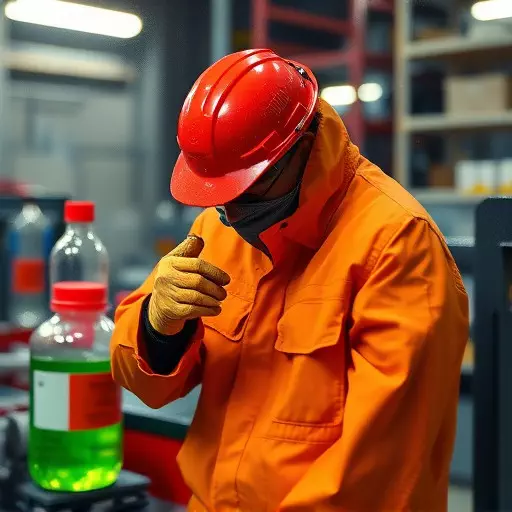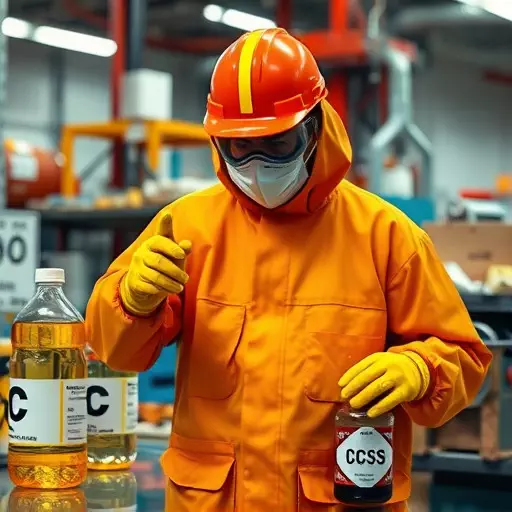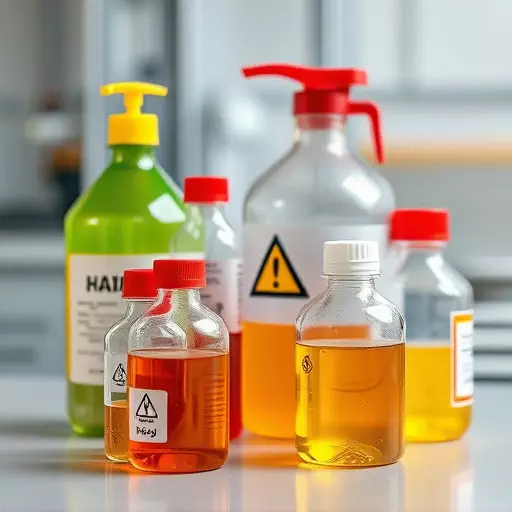Chemical exposure risk management is a structured process aimed at protecting workers in industries handling hazardous materials. It involves identifying and evaluating risks through detailed workplace surveys, SDS, and training, followed by implementing robust industrial hygiene protocols. These include engineering controls like ventilation and PPE, safe handling practices, regular monitoring, and continuous improvement based on audits and case studies. Effective hazardous material identification is key to empowering employees with safety knowledge, fostering a culture of proactive risk management, and ensuring compliance with regulations, ultimately leading to safer work environments.
In today’s industrial landscape, cross-industry collaboration on chemical safety is paramount. This article explores best practices in chemical exposure risk management, from foundational understanding to advanced strategies like industrial hygiene protocols and hazardous material identification. We delve into effective control measures, employee training, monitoring, and evaluation, drawing insights from case studies across diverse sectors. By integrating these practices, organizations can create safer working environments, protect their workforce, and enhance overall operational resilience.
- Understanding Chemical Exposure Risk Management: A Foundation for Safety
- Industrial Hygiene Protocols: Creating a Safe Working Environment
- Hazardous Material Identification: Recognizing and Classifying Risks
- Implementing Effective Control Measures for Chemical Hazards
- Employee Training and Education: Empowering a Culture of Awareness
- Monitoring and Evaluation: Assessing the Efficacy of Safety Practices
- Case Studies: Learning from Best (and Worst) Practices Across Industries
Understanding Chemical Exposure Risk Management: A Foundation for Safety

Chemical exposure risk management forms the bedrock of any comprehensive safety program within industrial settings. It involves a systematic approach to identify, assess, and mitigate risks associated with hazardous materials present in the workplace. This process begins with thorough hazardous material identification, where organizations meticulously catalog all chemicals used, stored, or produced on-site, along with their potential health and environmental impacts.
Once identified, these substances are subject to rigorous industrial hygiene protocols designed to minimize exposure. These protocols include implementing engineering controls such as ventilation systems, personal protective equipment (PPE), and safe handling procedures. Regular monitoring of air quality and worker health further ensures that any emerging risks are promptly addressed, fostering a culture of continuous improvement in chemical safety management.
Industrial Hygiene Protocols: Creating a Safe Working Environment

Industrial Hygiene Protocols play a pivotal role in creating a safe working environment, especially in industries dealing with hazardous materials and chemical exposure risk management. These protocols involve a comprehensive approach to identify, assess, and control potential hazards present in the workplace. By implementing strict measures, companies can ensure that employees are protected from any adverse effects of chemical substances, thereby fostering a healthier and more productive atmosphere.
Effective industrial hygiene practices commence with thorough hazardous material identification. This process involves conducting detailed surveys, employing advanced detection techniques, and maintaining up-to-date records to accurately categorize and quantify risks. Once identified, these hazards can be managed through engineering controls, administrative measures, and personal protective equipment (PPE), thereby minimizing or eliminating chemical exposure to workers.
Hazardous Material Identification: Recognizing and Classifying Risks

Chemical safety begins with accurate hazardous material identification. Recognizing and classifying risks associated with chemicals is a foundational step in effective chemical exposure risk management. Industrial hygiene protocols demand a thorough understanding of the potential dangers posed by substances within a workplace. This involves meticulous labeling, detailed safety data sheets (SDS), and comprehensive training for employees to ensure they can identify hazardous materials and respond appropriately.
By implementing robust hazardous material identification practices, organizations can significantly reduce the risks associated with chemical exposure. It empowers workers to take proactive measures, such as wearing appropriate personal protective equipment (PPE) and following safe handling procedures, thereby fostering a safer and healthier work environment.
Implementing Effective Control Measures for Chemical Hazards

Implementing effective control measures is paramount in managing chemical exposure risk across industries. The first step involves establishing robust industrial hygiene protocols that ensure proper ventilation, personal protective equipment (PPE), and safe handling procedures are in place. Regular training sessions for employees on hazardous material identification and safe disposal methods are crucial to creating a culture of safety.
Additionally, utilizing advanced technologies for monitoring chemical releases and leveraging data analytics can significantly enhance risk management. By integrating these practices, organizations can effectively mitigate the potential dangers associated with hazardous materials, thereby prioritizing the health and safety of workers while adhering to environmental regulations.
Employee Training and Education: Empowering a Culture of Awareness

In any chemical-centric industry, employee training and education are paramount in fostering a culture of awareness around safety. This involves equipping workers with the knowledge to identify hazardous materials, understand potential risks associated with chemical exposure, and learn best practices for risk management. Comprehensive industrial hygiene protocols should be implemented and regularly updated to ensure these programs remain effective. By providing ongoing training, companies can empower employees to take an active role in their safety, leading to a more proactive approach towards mitigating chemical-related hazards.
Effective education programs delve into topics such as proper handling techniques, personal protective equipment (PPE) usage, and emergency response procedures. This holistic training empowers employees to make informed decisions when confronted with situations that involve hazardous materials. Moreover, it instills a sense of responsibility, encouraging individuals to be vigilant and proactive in identifying potential risks and reporting them promptly. Such initiatives not only enhance individual safety but also contribute to the overall success and reputation of the organization by demonstrating a genuine commitment to chemical exposure risk management.
Monitoring and Evaluation: Assessing the Efficacy of Safety Practices

Effective chemical safety management requires continuous monitoring and evaluation to ensure that implemented practices are adequately mitigating risks. Regular audits and assessments help identify gaps in industrial hygiene protocols, particularly regarding hazardous material identification. By systematically reviewing exposure control measures, organizations can ascertain their efficacy in minimizing chemical exposure risk management.
This proactive approach involves analyzing both qualitative and quantitative data, including air quality monitoring results, employee health surveillance, and incident reports. Such evaluations are instrumental in refining safety procedures, ensuring compliance with regulatory standards, and fostering a culture of continuous improvement.
Case Studies: Learning from Best (and Worst) Practices Across Industries

Case studies offer a powerful tool for learning from both best and worst practices across industries when it comes to chemical safety. By examining real-world scenarios, organizations can gain valuable insights into effective strategies for managing chemical exposure risk. For instance, studying a successful implementation of industrial hygiene protocols in a pharmaceutical manufacturing facility can reveal key steps for minimizing worker exposure to hazardous materials. Conversely, examining incidents where chemical accidents occurred provides critical lessons on what not to do and helps identify red flags related to inadequate hazard identification processes.
These case studies serve as living examples of the importance of robust chemical safety measures. They underscore the value of regular reviews and updates to industrial hygiene protocols, emphasizing that even established industries must adapt and evolve their practices to stay ahead of emerging risks. By learning from both successful models and cautionary tales, organizations can cultivate a culture of proactive chemical exposure risk management, ensuring the safety and well-being of employees while maintaining operational efficiency.


